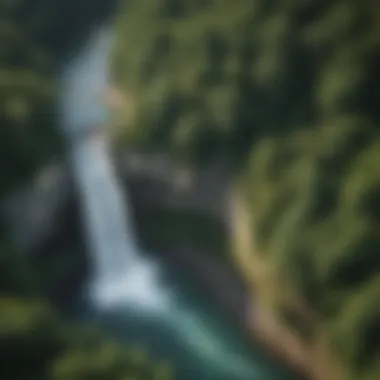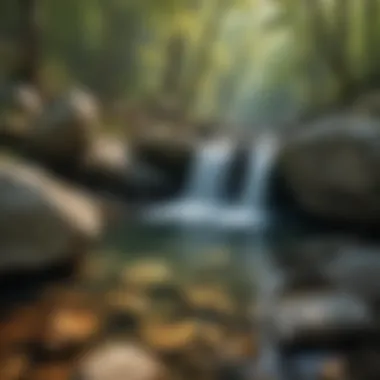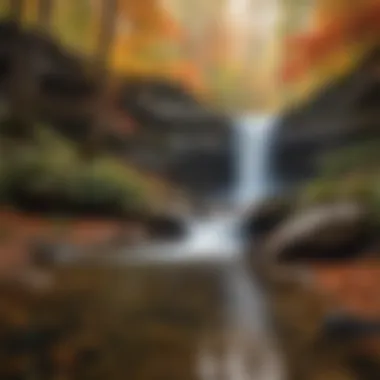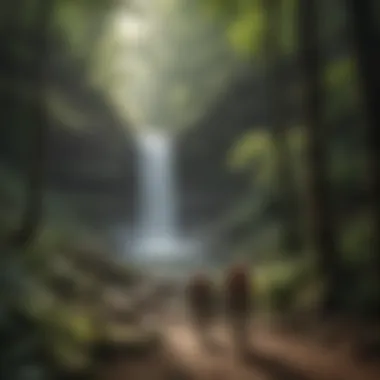Exploring the Enchantment of Waterfalls in Kentucky


Intro
Kentucky's waterfalls captivate those who seek both beauty and adventure. These natural wonders not only offer stunning visuals but also serve as vital components of the state’s diverse ecosystems. From cascading flows to tranquil pools, each waterfall has its unique charm and ecological role. This article will guide you through the most memorable waterfalls in Kentucky, giving insight into their geographical significance and the recreational opportunities they provide.
In the following sections, we will explore:
- Key waterfalls and their features
- Environmental importance of these ecosystems
- Activities for visitors and nature enthusiasts
Understanding the intersection of landscape and ecology is essential in appreciating Kentucky's natural heritage. It enhances our perspective of the region's ecological diversity and promotes sustainable visitation practices.
Geological Overview of Kentucky
The geological characteristics of Kentucky are fundamental to understanding its waterfalls. The interplay between the land's features and the water flow creates a unique ecosystem that supports diverse flora and fauna. This section will examine how the geological history of Kentucky shapes its landscape and significantly influences its waterfalls.
Geographical Features
Kentucky's geography is defined by its varied topography, from rolling hills to towering cliffs. The Appalachian Mountains to the east serve as a dramatic backdrop, while the central and western regions showcase fertile plains and waterways. This variety creates a setting where waterfalls can flourish, each formed by the interaction of water and rock.
The state's location influences its climate, making it conducive to both abundant rainfall and seasonal variations. Water gathers from numerous creeks and rivers, cascading down rocky outcrops, thus forming waterfalls. Notable geographical formations include the Kentucky River, which has carved deep gorges and numerous tributaries, providing ideal conditions for waterfall development.
Soil and Rock Types
The soil and rock in Kentucky play an essential role in determining where and how waterfalls develop. The rock formations here are primarily composed of limestone, dolomite, and shale. These sedimentary rocks are subject to erosion, which leads to the creation of features such as caves and gorges. The limestone regions are particularly significant, as they often produce softer, less resistant pathways for water to flow, leading to the formation of waterfalls.
Additionally, the soil composition varies across the state, impacting both drainage and water retention. This affects how waterfalls form, with particular regard to the types of vegetation that can thrive in proximity. Well-drained soils support a variety of plants, which stabilize the surrounding area and contribute to the ecological balance, enhancing the overall beauty of Kentucky's waterfalls.
Understanding these geological elements helps in appreciating not only the aesthetic beauty of waterfalls but also their ecological significance. The relationship between geology and hydrology in Kentucky is a testament to the intricate balance of nature.
Preface to Kentucky's Waterfalls
Kentucky's waterfalls are more than just aesthetic features; they are vital components of the state's ecology and cultural heritage. The presence of these waterfalls signifies a diverse hydrological landscape shaped by geological processes over millions of years. Understanding the importance of these waterfalls allows us to appreciate not only their beauty but also their role in local ecosystems and recreation.
Waterfalls serve as critical habitats for various plant and animal species, supporting biodiversity. They often create unique niches that are different from surrounding environments. This richness adds to the ecological tapestry of Kentucky, reinforcing the need for preservation and sustainable practices.
Waterfalls also provide recreational opportunities, drawing visitors who seek adventure or a serene escape. Hiking, photography, and eco-tourism around these natural wonders increase awareness and appreciation. Engaging with nature boosts mental and physical well-being, encouraging a connection to the land.
Additionally, the classification of waterfalls contributes to our understanding of their formation and significance. By categorizing these natural wonders, we can better communicate their unique attributes and importance to both local communities and visitors.
Significance of Waterfalls
Waterfalls are significant both ecologically and culturally. From an ecological perspective, waterfalls help regulate local climates by creating microhabitats and influencing water quality in adjacent streams and rivers. They also act as natural barriers, preventing certain species from migrating, which can lead to distinct evolutionary paths.
Culturally, many waterfalls are integral to local folklore and history. They serve as sites of spiritual importance and inspiration for artists and writers. The stories and legends surrounding these sites add to their allure, making them popular destinations.
In addition, waterfalls are essential for water management and offer services that benefit both wildlife and humans. They contribute to the water cycle by aiding in groundwater recharge and maintaining stream flow, which is crucial during dry periods.
Classification of Waterfalls


Waterfalls can be classified into several distinct types based on their characteristics and formation processes:
- Plunge Falls: These waterfalls drop vertically and connect to the stream below with little contact in the middle. They are dramatic and often attract visitors for their picturesque views.
- Cascade Falls: Characterized by a series of smaller drops and rapids, cascade falls create a flowing and continuous water movement, adding dynamism to their appearance.
- Block Falls: These waterfalls descend steeply over a wide cliff, giving them a solid and powerful presence.
- Multi-step Falls: Composed of several cascades or drops, multi-step falls create a tiered appearance and can be visually striking.
Each classification helps in identifying the geological processes that formed the waterfalls and aids in the conservation strategies that may be needed to protect them.
Notable Falls in Kentucky
Kentucky's waterfalls are exquisite features of the landscape that showcase the state's natural beauty and ecological diversity. They play an important role in local ecosystems and provide opportunities for recreation and education. Each notable fall has unique characteristics that contribute to the overall understanding of Kentucky's natural heritage. This section explores some of the most prominent waterfalls, emphasizing their geological, recreational, and historical significance.
Cumberland Falls
Location and Accessibility
Cumberland Falls is often referred to as the "Niagara of the South." It is located in the Cumberland Falls State Resort Park, easily accessible from U.S. Route 27. This particular location makes it a popular destination for both locals and tourists. The park offers ample parking and marked trails that lead to the falls, allowing visitors to experience the beauty without strenuous effort. Accessibility enhances visitors’ experience, as they can enjoy breathtaking views with relative ease.
Historical Significance
Cumberland Falls is rich in history, having been a significant site for Native American tribes for centuries. The area was used for trade and cultural rituals long before European settlers arrived. In the 20th century, the falls witnessed efforts to preserve its natural environment, leading to the establishment of the state park in 1936. This historical aspect adds depth to a visit, as one can appreciate not just the scenery, but also the cultures intertwined with it.
Unique Features
One notable feature of Cumberland Falls is the full moon rising over the falls, which creates a rare phenomenon known as the "moonbow." This occurs when the light from the moon refracts through the mist, creating a rainbow at night. Being one of the few places in the world where this occurs regularly, it attracts photographers and nature lovers alike. The unique phenomenon enhances the allure of the falls and encourages night-time visits, adding layers to the visitor experience.
Red River Gorge Falls
Geological Formation
The Red River Gorge is known for its stunning sandstone cliffs and natural arches. The geological formation of the falls in this area is a result of erosion from the river over thousands of years. This makes the falls a point of interest for geology enthusiasts. The unique rock formations tell a story of the earth’s past, offering insight into the natural forces that shaped the landscape.
Surrounding Ecosystems
The ecosystem around Red River Gorge Falls is vibrant and diverse. It is home to various species of flora and fauna, many of which thrive in the moist environment created by the falls. The lush vegetation provides habitat for wildlife, including deer, foxes, and numerous bird species. This ecological richness makes the area vital for biodiversity, underscoring its importance in conservation efforts.
Recreational Activities
Visitors at Red River Gorge Falls can engage in various recreational activities, including hiking, rock climbing, and kayaking. The numerous trails offer options for all skill levels. Additionally, the scenic beauty of the area enhances outdoor experiences, drawing in adventure seekers and families. Recreational opportunities enrich the overall significance of the falls, encouraging a connection with nature.
Creation Falls
Scenic Views
Creation Falls is celebrated for its breathtaking views. The falls cascade over a rugged landscape, providing picturesque sights regardless of the angle from which they are viewed. Many visitors come specifically for photography. The scenic backdrop creates a peaceful atmosphere, inviting contemplation and appreciation of the natural world. This beauty contributes significantly to the falls' reputation as a top destination in Kentucky.
Visitor Information
Located within the Daniel Boone National Forest, visitor information about Creation Falls is well organized. Maps and guides are readily available, aiding in navigating trails and understanding park rules. This accessibility enhances the visitor experience, making it easier to enjoy the surroundings without confusion or difficulty. Ensuring visitors are informed promotes environmentally responsible behavior in the park.
Seasonal Variations


Seasonal variations at Creation Falls are striking, with changing water levels and foliage colors throughout the year. Spring brings vibrant greenery, while autumn offers stunning hues of red and gold. Such changes are captivating and serve to educate visitors about the life cycles of the flora and fauna surrounding the falls. Observing these variations can lead to repeated visits at different times of the year, fostering a deeper appreciation for natural cycles.
Yahoo Falls
Access and Trails
Yahoo Falls is another impressive waterfall that features well-maintained trails leading to it. Located in the Yahoo Falls Recreation Area, the routes are clearly marked and accessible for hikers of various experience levels. The trail system enhances the experience, as visitors can enjoy the natural environment on their way to the falls. This accessibility makes Yahoo Falls a popular choice among hikers and outdoor enthusiasts.
Ecological Significance
The ecological significance of Yahoo Falls is considerable, as the surrounding area houses unique plant species and wildlife. The habitat supports various ecosystems, contributing to the environmental balance. Educating visitors on this importance raises awareness about conservation. Understanding the delicate nature of the ecosystem enhances the value of the visit, linking enjoyment with responsibility to protect these natural wonders.
Cultural Narratives
The cultural narratives surrounding Yahoo Falls are rich with local folklore and stories passed down through generations. Native American legends speak of the mystique of the falls, while more recent tales highlight the exploration of the region. Such narratives add an enriching layer to the visit, inviting guests to engage with the cultural history of the falls and their significance to local communities. This cultural relevance provides deeper context and appreciation for the stunning natural site.
Biodiversity Around Waterfalls
Waterfalls in Kentucky are not just striking visual spectacles; they are also critical reservoirs of biodiversity. They create unique ecosystems that support a diverse range of flora and fauna. The diverse habitats surrounding these waterfalls are shaped by distinct microclimates, moisture levels, and substrate types. These elements contribute to the overall ecological richness found in these areas, making them essential for conservation efforts.
Flora and Fauna
The presence of waterfalls influences the types of plant and animal species that can thrive in these environments. The constant movement of water creates varying moisture levels, which supports lush plant communities.
Among the vegetation, species such as ferns, mosses, and certain wildflowers flourish on the rocky outcrops and alongside streams. This rich plant life forms a complex habitat that offers food and shelter to various animal species. Additionally, waterfalls provide habitat for specific aquatic species, including native fish and amphibians. These creatures depend on clean, oxygen-rich waters for survival, which are often found near waterfalls.
Some of the notable fauna include:
- Eastern Wild Turkey: These birds can commonly be seen foraging in the forested areas surrounding waterfalls.
- Various Salamanders: Many species depend on the humid microhabitats found in proximity to falls.
- Cave-dwelling Bats: Certain species use the cool, shaded areas around waterfalls as roosting spots.
"Waterfalls act as natural sanctuaries, fostering endemic species that withstand specific environmental pressures."
Habitat Preservation
The preservation of habitats around waterfalls is vital for maintaining biodiversity in Kentucky. As human activities encroach upon these natural areas, the ecosystems that thrive around falls face numerous threats. Factors such as pollution, deforestation, and increased tourism disturb the delicate balance of these environments.
Conservation initiatives have focused on several key areas, including:
- Water Quality Monitoring: Regular assessments to keep aquatic habitats healthy.
- Reforestation Efforts: Planting native trees to restore areas that have lost vegetation.
- Visitor Education: Informing the public about responsible practices to minimize their impact on local ecosystems.
Ultimately, safeguarding the diverse life forms around Kentucky's waterfalls is crucial. It not only helps preserve these regions for future generations but also enhances the overall health of our environment.
Conservation Efforts
Conservation efforts play a crucial role in preserving the unique beauty and ecological diversity of Kentucky's waterfalls. These sites are not only geological marvels but also vital components of the surrounding ecosystems. Protecting these natural resources helps ensure that they can be enjoyed by future generations. Conservation initiatives often focus on mitigating environmental degradation, fostering biodiversity, and supporting local communities involved in conservation activities.
Impact of Human Activities
Human activities have significant effects on the health and sustainability of Kentucky's waterfalls. Urban development, agriculture, and tourism can lead to habitat destruction, water pollution, and altered water flow. For instance, increased sediment from construction sites can cloud waters, affecting aquatic life. Additionally, pollution from agricultural runoff can introduce harmful chemicals into waterways, leading to declines in fish and plant populations. It is essential to monitor these impacts closely and implement regulations that minimize harm while allowing for safe recreational use.


Community Involvement
Active community involvement is pivotal for successful conservation efforts. Local organizations and volunteers often organize clean-up events and educational workshops to raise awareness about the fragility of these ecosystems. They create programs that foster stewardship among residents, encouraging them to take part in monitoring water quality and protecting native species. Moreover, partnerships between governmental agencies, non-profits, and the local community can lead to more efficient allocation of resources for conservation projects. Engaging the public not only promotes education about environmental issues but also cultivates a shared sense of responsibility towards preserving Kentucky's natural heritage.
"Sustainable practices can ensure that our natural wonders endure, allowing us to continue to appreciate their beauty without compromising their integrity."
The confluence of recognizing the impact of human activities and fostering community involvement creates a robust framework for conservation. By taking dedicated steps towards preserving these waterfalls, Kentucky can maintain its ecological integrity while promoting responsible enjoyment of its natural treasures.
Visiting Waterfalls in Kentucky
Visiting waterfalls presents a unique opportunity to connect with nature. In Kentucky, this experience is enhanced due to the remarkable diversity of its waterfalls. Exploring these natural attractions not only offers scenic views but also promotes mental and physical well-being while immersing visitors in the local ecosystem. The state's rich geological heritage and the biodiversity surrounding these falls encourage engagement with conservation efforts.
Best Times to Visit
The timing of a visit can significantly influence the waterfall experience. Spring is often considered the best season for viewing waterfalls in Kentucky, as rain transforms the falls into powerful torrents. April and May showcase lush greenery and blooming wildflowers, adding to the aesthetic appeal.
However, early fall also provides a stunning backdrop. The foliage changes colors, creating beautiful contrasts against the rushing water. Visitors are advised to check weather reports prior to their trip to ensure optimal conditions.
Safety Considerations
Safety is essential when visiting any natural site. The terrain around waterfalls can be challenging and may present hazards. It is critical to stay on designated paths to avoid accidents. Being aware of slippery rocks and steep drop-offs can help prevent falls. In addition, understanding local wildlife behaviors, particularly if hiking in remote areas, is important. Always inform someone of your travel plans to increase safety in case of emergencies.
Local Amenities
Accessing waterfalls can involve traveling to remote areas, so local amenities should be noted. Many popular falls, such as Cumberland Falls, have visitor centers equipped with information and facilities. State parks often offer picnic areas, restrooms, and basic supplies. For longer treks, nearby towns provide options for food and lodging. Being familiar with available resources ensures a smoother experience.
"Exploring Kentucky's waterfalls adds a rich dimension to understanding the state's ecological diversity. Plan visits during favorable seasons."
In summary, visiting Kentucky's waterfalls is not just about appreciating their beauty but engaging with the local ecology and conserving these natural wonders for future generations. Prior planning and safety measures enhance enjoyment and foster a deeper connection to the environment.
Future of Kentucky's Waterfalls
The future of Kentucky's waterfalls holds significant relevance in discussions about regional environmental conservation and sustainable tourism. These natural wonders are not just aesthetic treasures; they are critical habitats and indicators of the health of local ecosystems. As climate change and human activity increasingly impact the environment, the long-term viability of Kentucky's waterfalls depends on proactive measures to protect them.
It is crucial to address both environmental challenges and the rise of sustainable tourism practices. Their intersection shapes how we preserve these natural sites while allowing communities to benefit economically. This balance is essential, especially for local economies that rely on tourism. Understanding these dynamics provides insights into the broader implications of maintaining ecological integrity while promoting visitor engagement with the natural environment.
Environmental Challenges
Kentucky's waterfalls face several environmental challenges that threaten their sustainability. One prominent issue is pollution. Runoff from agricultural practices often introduces harmful chemicals and sediments into water sources, diminishing water quality and impacting aquatic life. Additionally, deforestation associated with development projects leads to increased erosion and sedimentation in rivers and streams. This can result in altered water flow, which, over time, may affect the physical characteristics of waterfalls.
Another critical challenge is climate change. Shifts in weather patterns can lead to prolonged droughts or increased rainfall. Such changes not only alter the flow of water but may also affect the ecological communities that thrive in these areas. The migratory patterns of certain species may be disrupted, as they depend on stable water conditions for reproduction and feeding.
In light of these challenges, it is essential to implement strategies that focus on:
- Water Quality Monitoring: Regular assessments to ensure water remains clean and healthy for both ecosystems and visitors.
- Riparian Buffer Zones: Creating zones along waterways to help absorb excess nutrients and sediments.
- Habitat Restoration Projects: Initiatives aimed at restoring degraded areas around waterfalls to maintain biodiversity.
Sustainable Tourism Practices
Sustainable tourism practices offer a pathway to protect Kentucky's waterfalls while encouraging economic benefits. Efforts to promote responsible tourism can safeguard the natural environment and enhance the visitor experience. Key sustainable practices include:
- Education and Awareness: Informing visitors about the ecological significance of waterfalls helps foster a culture of stewardship. Tour operators and local guides can play a pivotal role in this educational exchange.
- Controlled Access: Limiting visitor numbers in sensitive areas can alleviate stress on natural resources while ensuring a more enjoyable experience.
- Eco-friendly Infrastructure: Developing facilities that minimize environmental impact, such as eco-toilets and solar-powered amenities, contributes to a more sustainable visitor experience.
- Partnerships with Local Communities: Engaging local residents in tourism management can strengthen community ties and ensure that the benefits of tourism are shared economically.
"The preservation of natural beauty is a duty we owe to the earth and ourselves."
By understanding and acting on these issues, we can ensure that the waterfalls of Kentucky remain a source of wonder and ecological richness.



